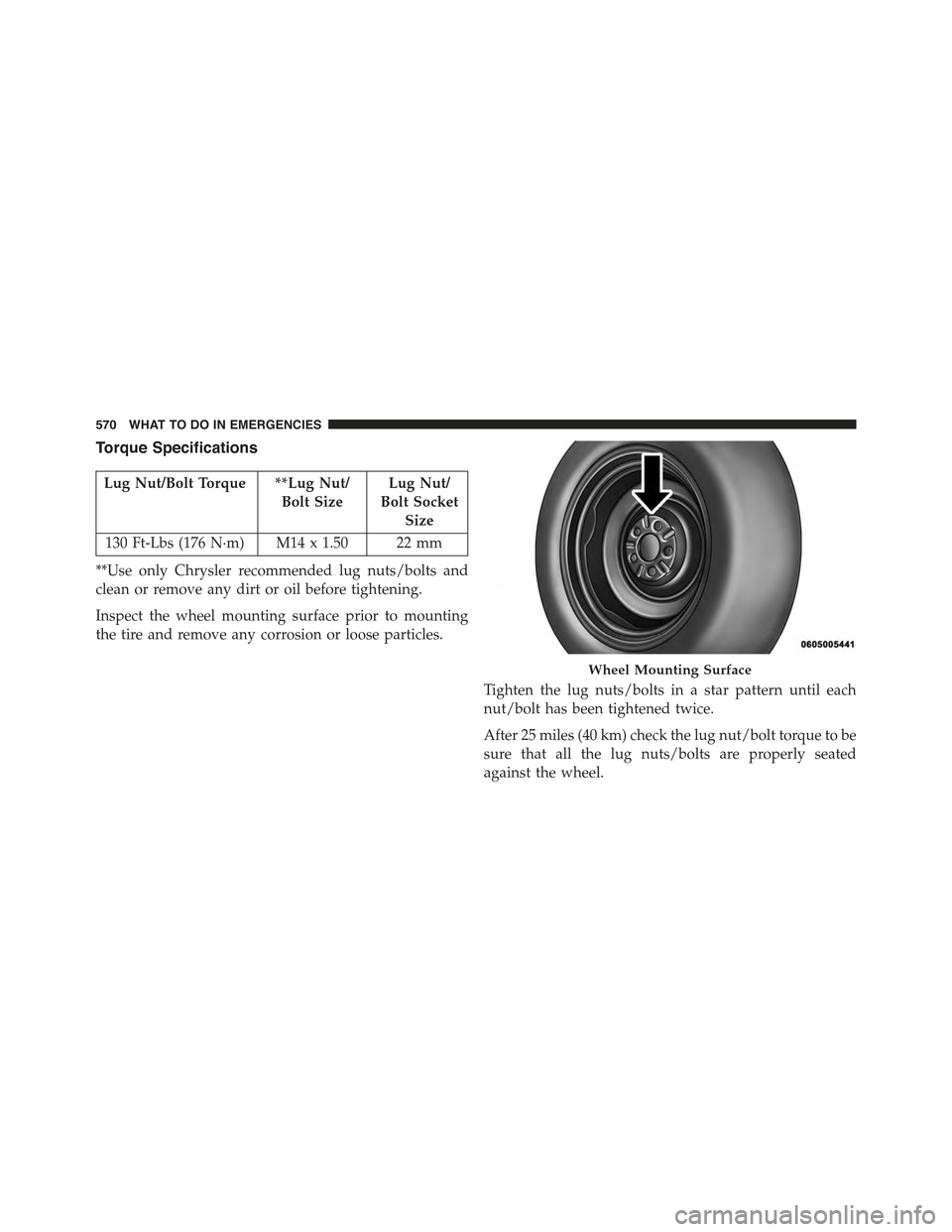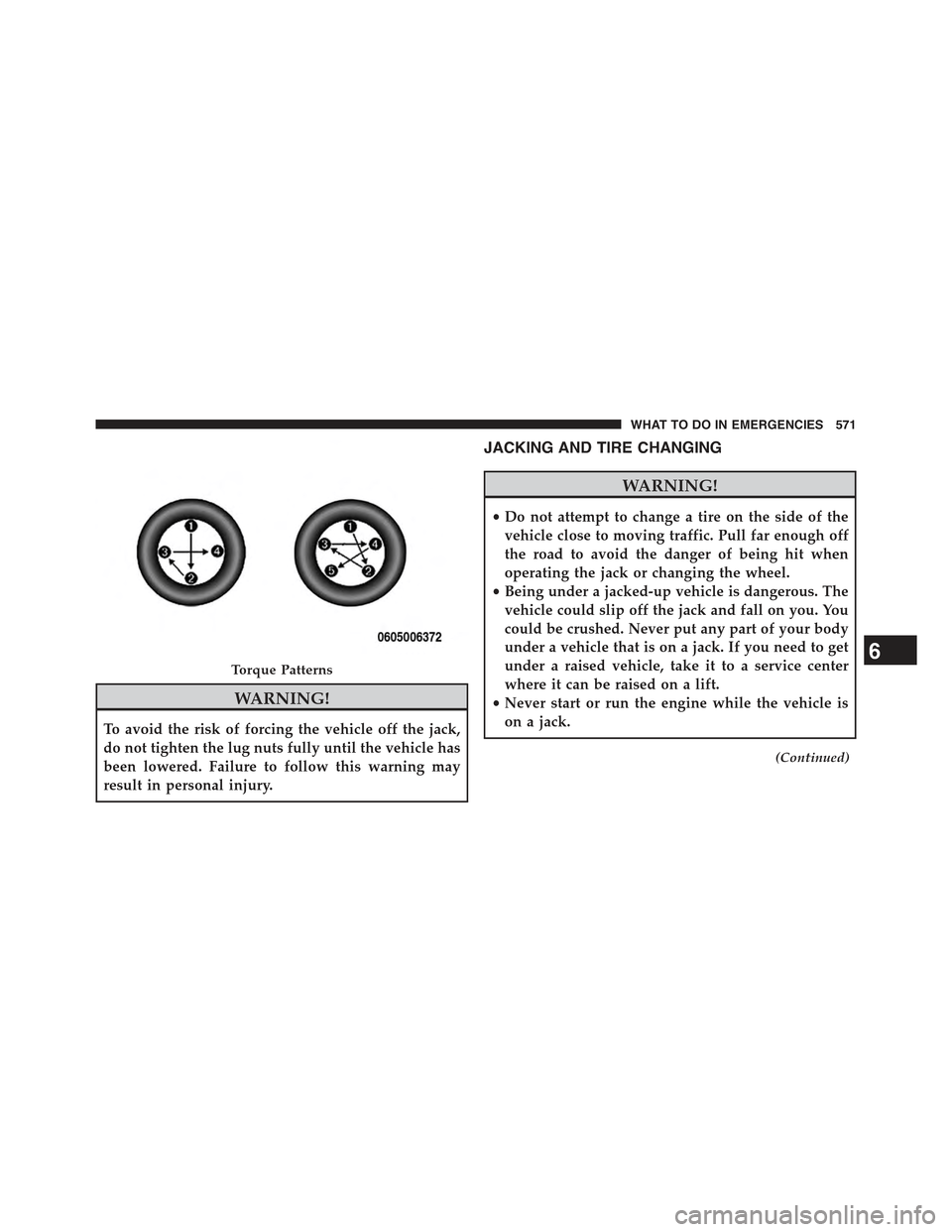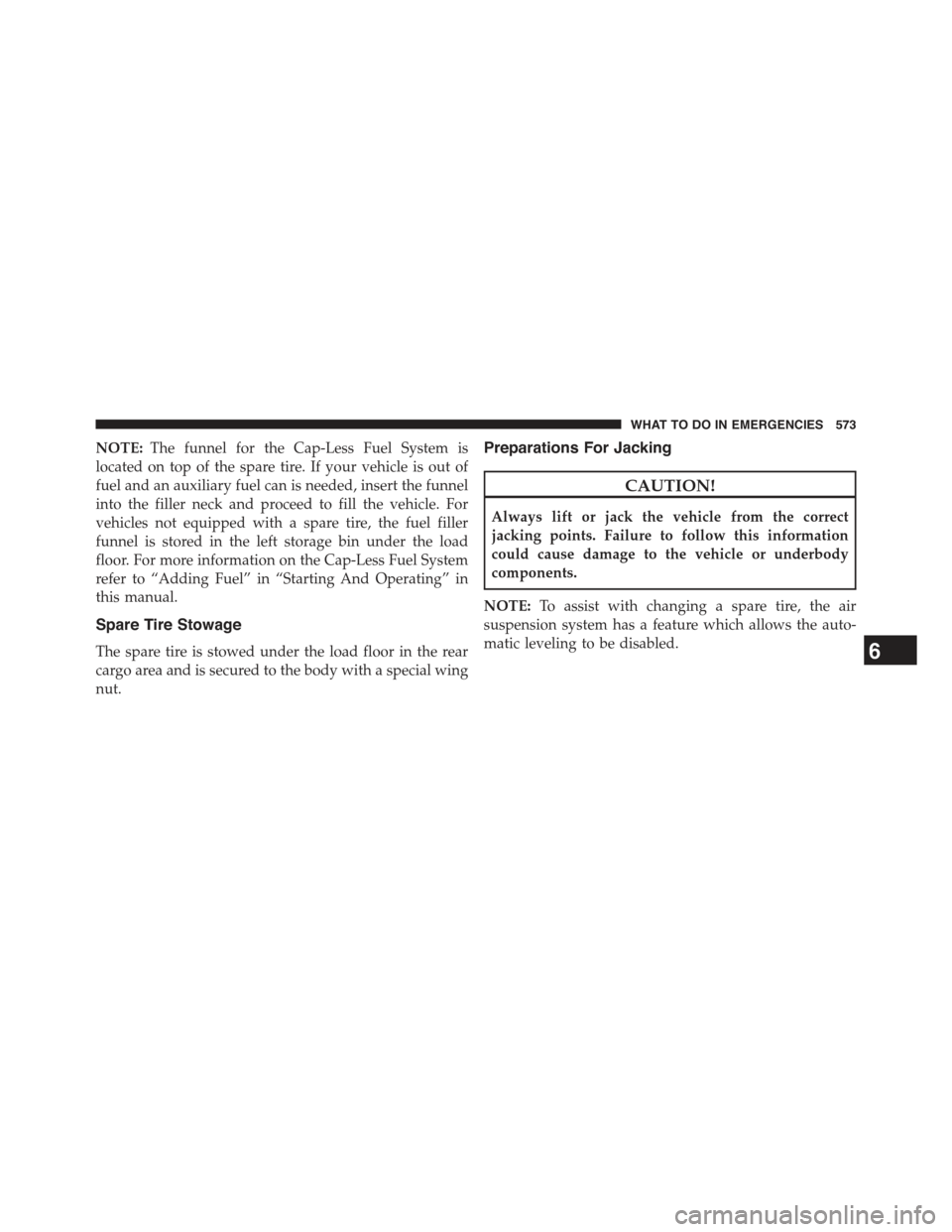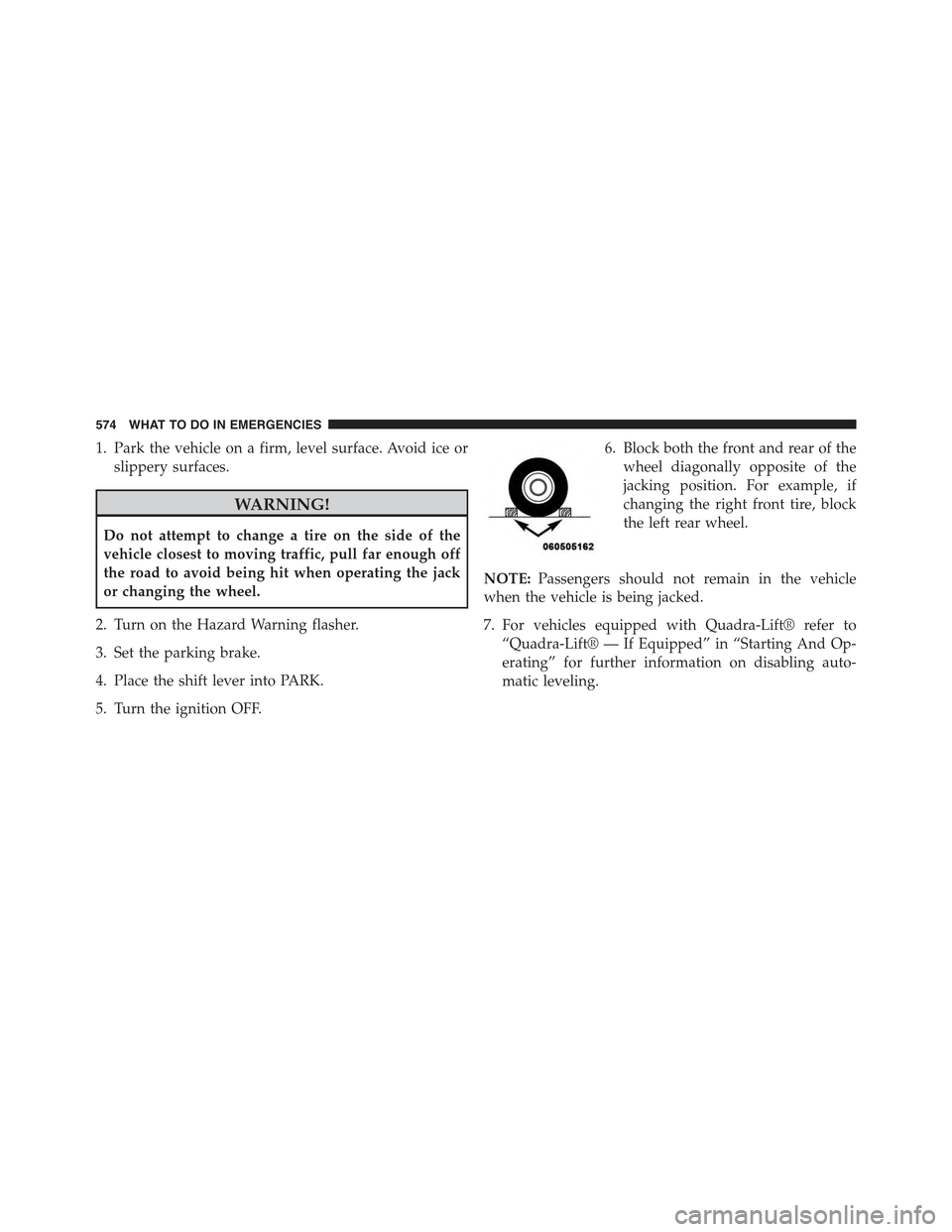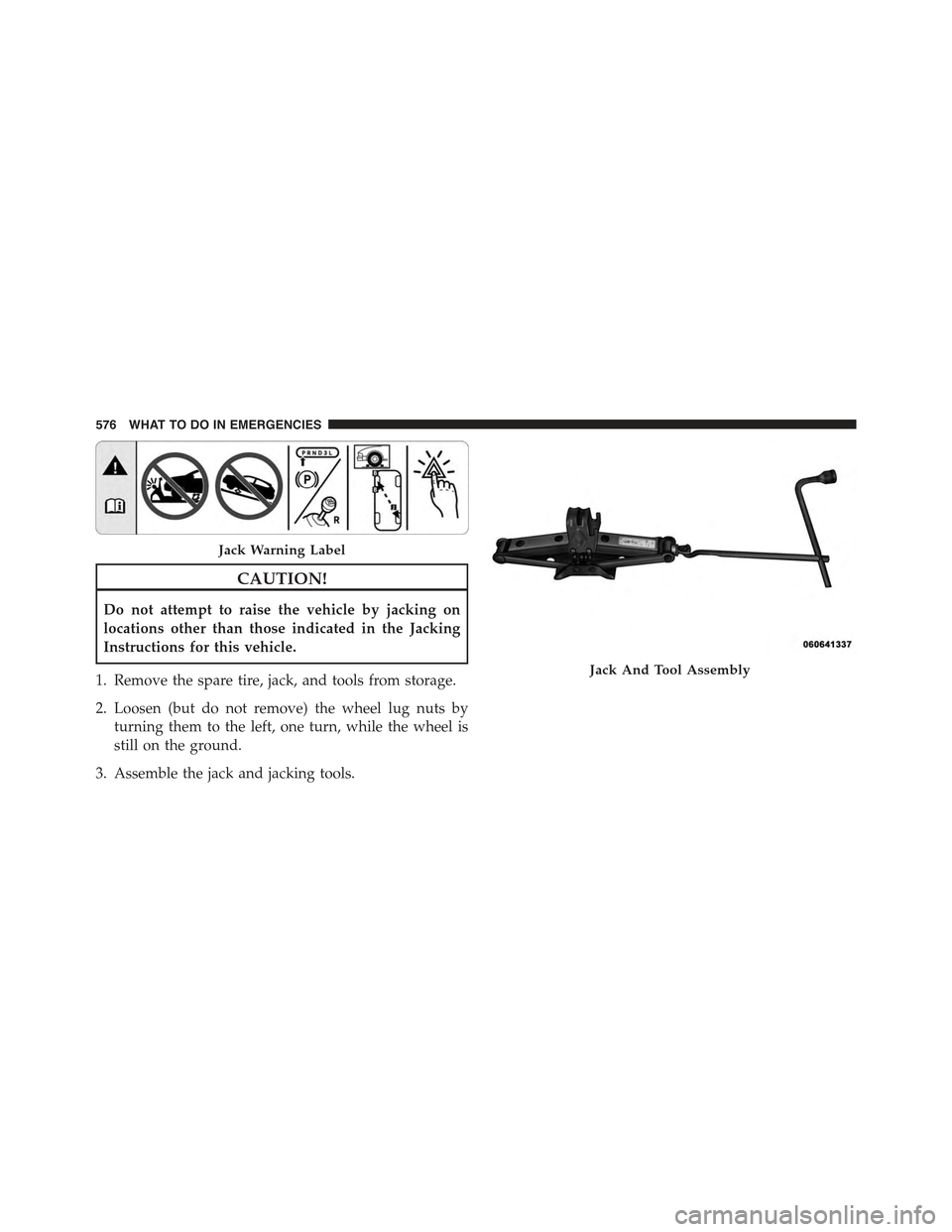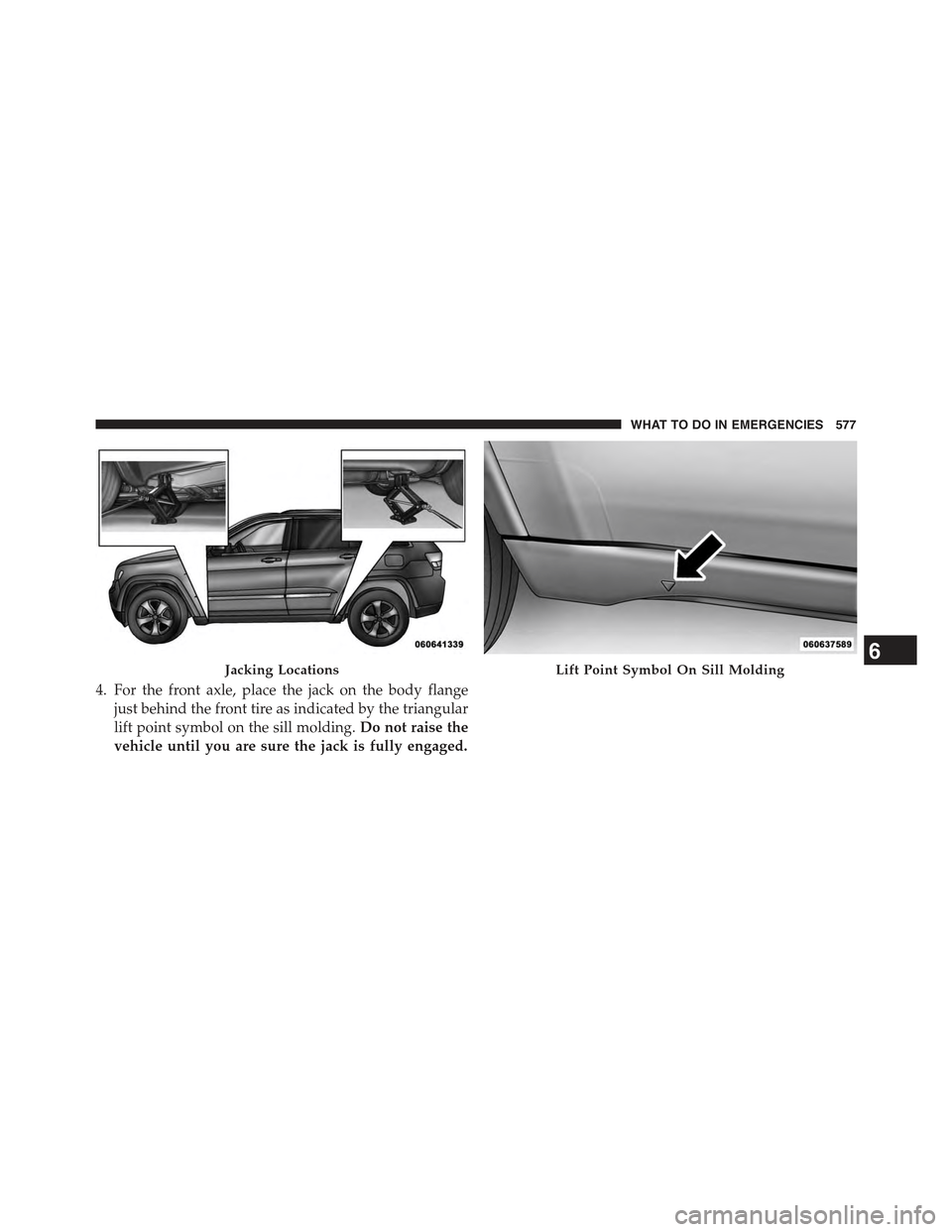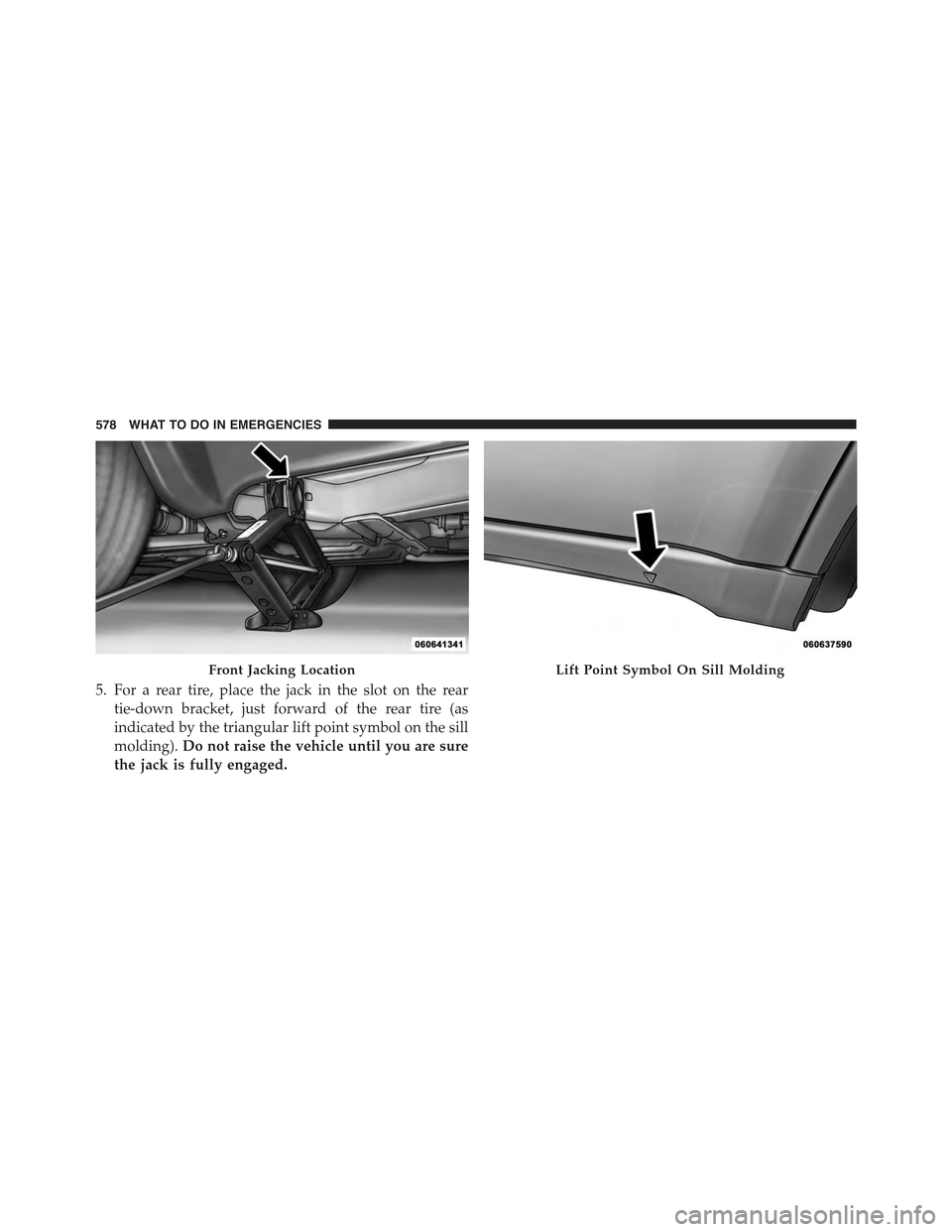JEEP GRAND CHEROKEE 2015 WK2 / 4.G Owners Manual
GRAND CHEROKEE 2015 WK2 / 4.G
JEEP
JEEP
https://www.carmanualsonline.info/img/16/7109/w960_7109-0.png
JEEP GRAND CHEROKEE 2015 WK2 / 4.G Owners Manual
Trending: fuses, automatic transmission fluid, wheel torque, lumbar support, jump start, oil reset, suspension
Page 571 of 717
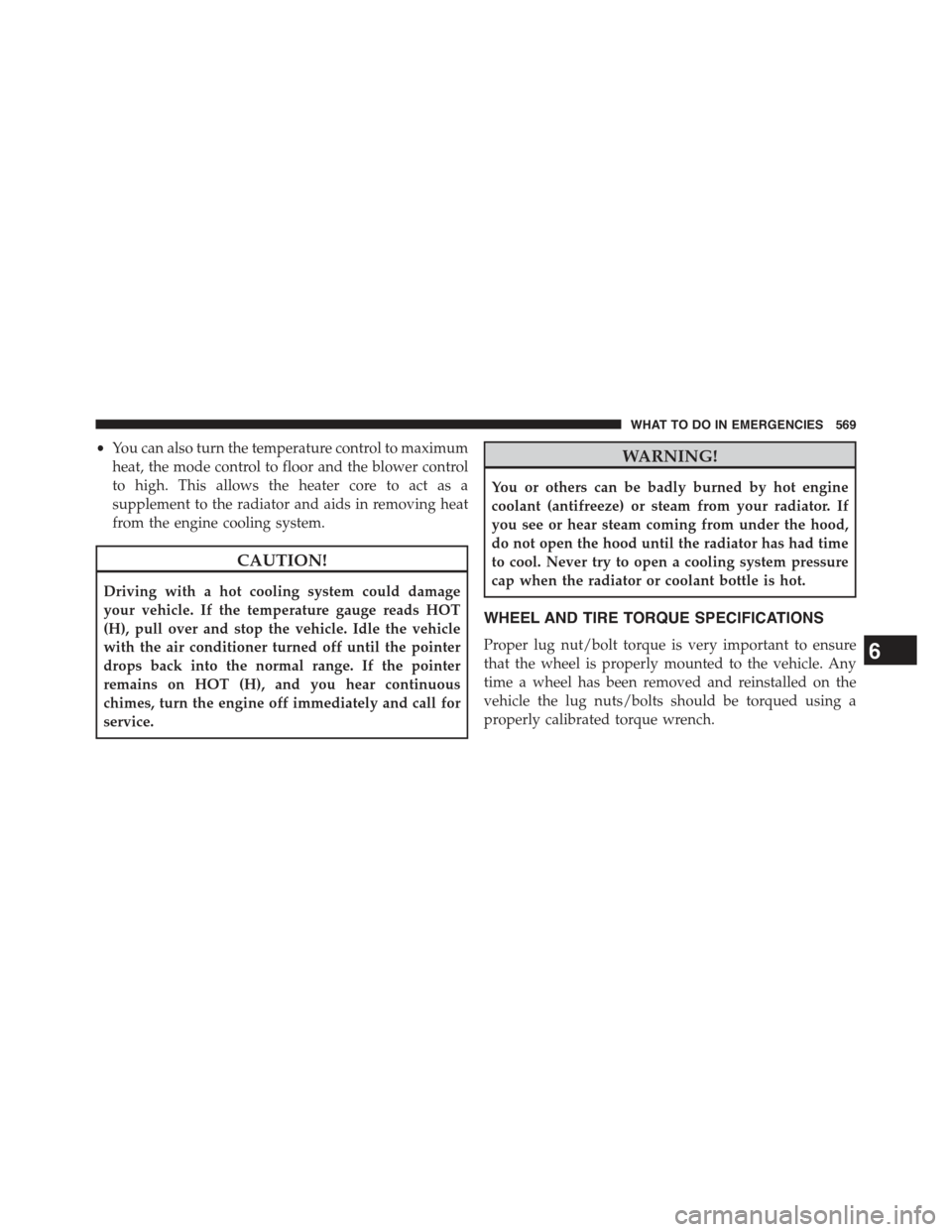
•You can also turn the temperature control to maximum
heat, the mode control to floor and the blower control
to high. This allows the heater core to act as a
supplement to the radiator and aids in removing heat
from the engine cooling system.
CAUTION!
Driving with a hot cooling system could damage
your vehicle. If the temperature gauge reads HOT
(H), pull over and stop the vehicle. Idle the vehicle
with the air conditioner turned off until the pointer
drops back into the normal range. If the pointer
remains on HOT (H), and you hear continuous
chimes, turn the engine off immediately and call for
service.
WARNING!
You or others can be badly burned by hot engine
coolant (antifreeze) or steam from your radiator. If
you see or hear steam coming from under the hood,
do not open the hood until the radiator has had time
to cool. Never try to open a cooling system pressure
cap when the radiator or coolant bottle is hot.
WHEEL AND TIRE TORQUE SPECIFICATIONS
Proper lug nut/bolt torque is very important to ensure
that the wheel is properly mounted to the vehicle. Any
time a wheel has been removed and reinstalled on the
vehicle the lug nuts/bolts should be torqued using a
properly calibrated torque wrench.
6
WHAT TO DO IN EMERGENCIES 569
Page 572 of 717
Torque Specifications
Lug Nut/Bolt Torque **Lug Nut/
Bolt Size
Lug Nut/
Bolt Socket
Size
130 Ft-Lbs (176 N·m) M14 x 1.50 22 mm
**Use only Chrysler recommended lug nuts/bolts and
clean or remove any dirt or oil before tightening.
Inspect the wheel mounting surface prior to mounting
the tire and remove any corrosion or loose particles.
Tighten the lug nuts/bolts in a star pattern until each
nut/bolt has been tightened twice.
After 25 miles (40 km) check the lug nut/bolt torque to be
sure that all the lug nuts/bolts are properly seated
against the wheel.
Wheel Mounting Surface
570 WHAT TO DO IN EMERGENCIES
Page 573 of 717
WARNING!
To avoid the risk of forcing the vehicle off the jack,
do not tighten the lug nuts fully until the vehicle has
been lowered. Failure to follow this warning may
result in personal injury.
JACKING AND TIRE CHANGING
WARNING!
•Do not attempt to change a tire on the side of the
vehicle close to moving traffic. Pull far enough off
the road to avoid the danger of being hit when
operating the jack or changing the wheel.
•Being under a jacked-up vehicle is dangerous. The
vehicle could slip off the jack and fall on you. You
could be crushed. Never put any part of your body
under a vehicle that is on a jack. If you need to get
under a raised vehicle, take it to a service center
where it can be raised on a lift.
•Never start or run the engine while the vehicle is
on a jack.
(Continued)
Torque Patterns6
WHAT TO DO IN EMERGENCIES 571
Page 574 of 717
WARNING!(Continued)
•The jack is designed to be used as a tool for
changing tires only. The jack should not be used to
lift the vehicle for service purposes. The vehicle
should be jacked on a firm level surface only.
Avoid ice or slippery areas.
Jack Location
The scissor-type jack and tire changing tools are located
in rear cargo area, below the load floor.
Jack Storage Location
572 WHAT TO DO IN EMERGENCIES
Page 575 of 717
NOTE:The funnel for the Cap-Less Fuel System is
located on top of the spare tire. If your vehicle is out of
fuel and an auxiliary fuel can is needed, insert the funnel
into the filler neck and proceed to fill the vehicle. For
vehicles not equipped with a spare tire, the fuel filler
funnel is stored in the left storage bin under the load
floor. For more information on the Cap-Less Fuel System
refer to “Adding Fuel” in “Starting And Operating” in
this manual.
Spare Tire Stowage
The spare tire is stowed under the load floor in the rear
cargo area and is secured to the body with a special wing
nut.
Preparations For Jacking
CAUTION!
Always lift or jack the vehicle from the correct
jacking points. Failure to follow this information
could cause damage to the vehicle or underbody
components.
NOTE:To assist with changing a spare tire, the air
suspension system has a feature which allows the auto-
matic leveling to be disabled.6
WHAT TO DO IN EMERGENCIES 573
Page 576 of 717
1. Park the vehicle on a firm, level surface. Avoid ice or
slippery surfaces.
WARNING!
Do not attempt to change a tire on the side of the
vehicle closest to moving traffic, pull far enough off
the road to avoid being hit when operating the jack
or changing the wheel.
2. Turn on the Hazard Warning flasher.
3. Set the parking brake.
4. Place the shift lever into PARK.
5. Turn the ignition OFF.
6. Block both the front and rear of the
wheel diagonally opposite of the
jacking position. For example, if
changing the right front tire, block
the left rear wheel.
NOTE:Passengers should not remain in the vehicle
when the vehicle is being jacked.
7. For vehicles equipped with Quadra-Lift® refer to
“Quadra-Lift® — If Equipped” in “Starting And Op-
erating” for further information on disabling auto-
matic leveling.
574 WHAT TO DO IN EMERGENCIES
Page 577 of 717
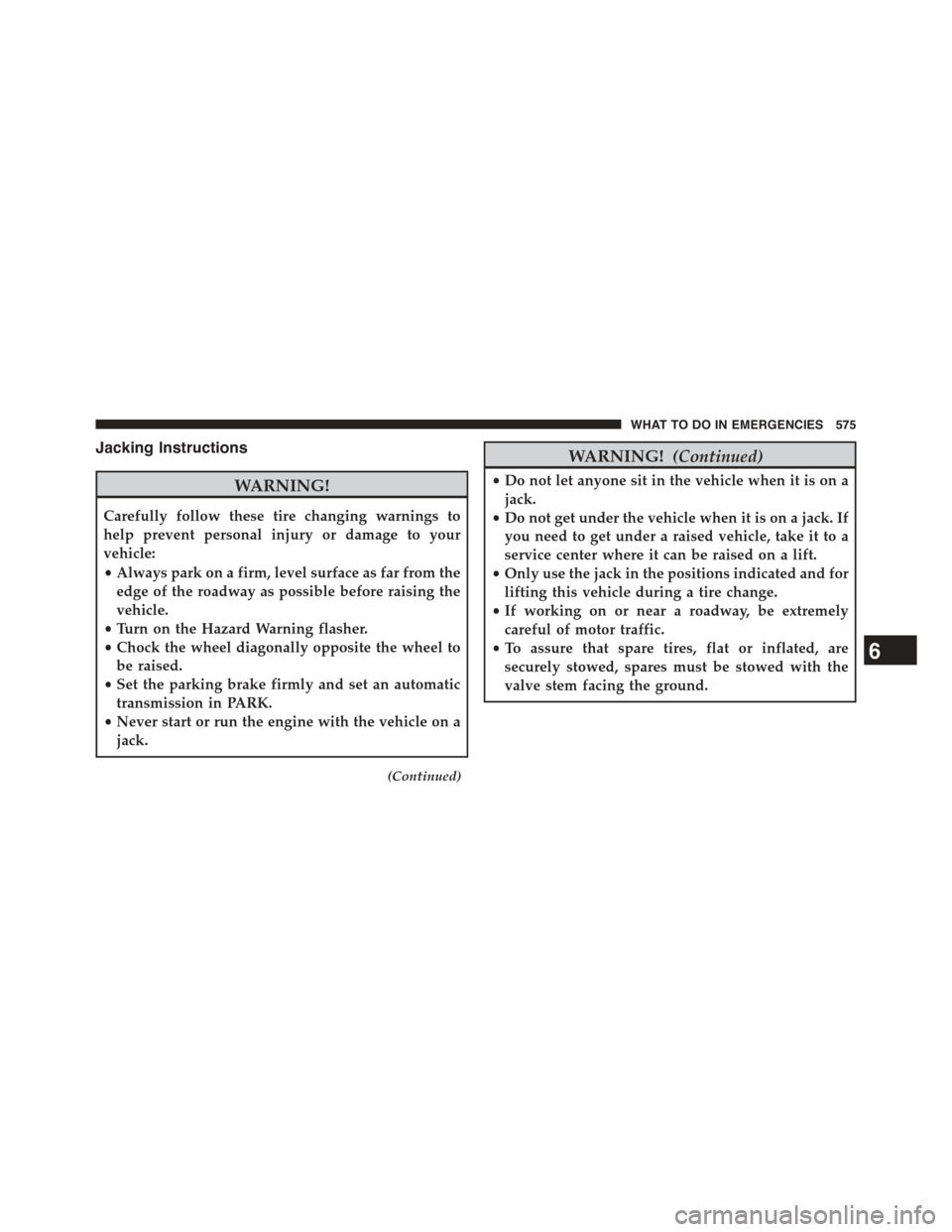
Jacking Instructions
WARNING!
Carefully follow these tire changing warnings to
help prevent personal injury or damage to your
vehicle:
•Always park on a firm, level surface as far from the
edge of the roadway as possible before raising the
vehicle.
•Turn on the Hazard Warning flasher.
•Chock the wheel diagonally opposite the wheel to
be raised.
•Set the parking brake firmly and set an automatic
transmission in PARK.
•Never start or run the engine with the vehicle on a
jack.
(Continued)
WARNING!(Continued)
•Do not let anyone sit in the vehicle when it is on a
jack.
•Do not get under the vehicle when it is on a jack. If
you need to get under a raised vehicle, take it to a
service center where it can be raised on a lift.
•Only use the jack in the positions indicated and for
lifting this vehicle during a tire change.
•If working on or near a roadway, be extremely
careful of motor traffic.
•To assure that spare tires, flat or inflated, are
securely stowed, spares must be stowed with the
valve stem facing the ground.
6
WHAT TO DO IN EMERGENCIES 575
Page 578 of 717
CAUTION!
Do not attempt to raise the vehicle by jacking on
locations other than those indicated in the Jacking
Instructions for this vehicle.
1. Remove the spare tire, jack, and tools from storage.
2. Loosen (but do not remove) the wheel lug nuts by
turning them to the left, one turn, while the wheel is
still on the ground.
3. Assemble the jack and jacking tools.
Jack Warning Label
Jack And Tool Assembly
576 WHAT TO DO IN EMERGENCIES
Page 579 of 717
4. For the front axle, place the jack on the body flange
just behind the front tire as indicated by the triangular
lift point symbol on the sill molding.Do not raise the
vehicle until you are sure the jack is fully engaged.
Jacking LocationsLift Point Symbol On Sill Molding6
WHAT TO DO IN EMERGENCIES 577
Page 580 of 717
5. For a rear tire, place the jack in the slot on the rear
tie-down bracket, just forward of the rear tire (as
indicated by the triangular lift point symbol on the sill
molding).Do not raise the vehicle until you are sure
the jack is fully engaged.
Front Jacking LocationLift Point Symbol On Sill Molding
578 WHAT TO DO IN EMERGENCIES
Trending: pairing phone, headlights, oil reset, washer fluid, service interval, winter tires, automatic transmission fluid

